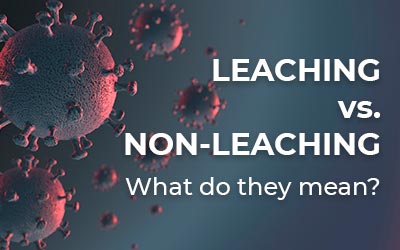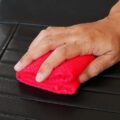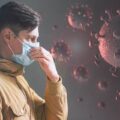What does it mean in the Context of Covid-19, Disinfection and Infection Control?
The human race has recently been effectively parasitised as the transmission vectors of a lethal pathogenic virus called COVID-19. This virus has adapted and evolved rapidly to spread efficiently and effectively from one victim to another. In this technical paper, created by Big Red in Singapore, we will examine the pivotal role that effective disinfection can play in combatting the spread of this insidious, dangerous disease.
Ubiquitous Pathogens
Our living, working and recreational environments are quite naturally shared with myriads of micro-organisms, some of them good, some of them passive and a small percentage are harmful. Micro-organisms that are harmful and through infecting humans and causing disease are known as ‘pathogens. However, it is usually the pathogenic organisms that capture all the headlines!
Everyday, there is a news story somewhere about a facility facing closure due to yet another problem with Clostridium difficile, methicillin resistant Staphylococcus aureus, Aspergillus fumigatus, Legionella pneumophila or more recently, the global headline-grabbing star of the show, the COVID-19 virus!
Germ Condominium
Unfortunately, many of the buildings we occupy are little more than “germ condominiums” from the perspective of opportunistic infectious microbes, a plethora of places for bacteria, viruses and fungi to grow, reproduce or simply just survive and lie in wait. Waiting to complete the only mission in their microscopic life; to infect as many humans as possible, spread as far as possible and proliferate as much as they can. The Novel Coronavirus (COVID-19) has, by adaption, mutation and rapid evolution mastered the art of pathogenesis and correspondingly, now poses the most significant global risk to human health.
Novel Coronavirus (COVID-19)
As we now know from the headlines, phone App’s and social media, a new, highly virulent and highly contagious disease called ‘Novel Coronavirus Disease’ or ‘COVID-19’ for short, is currently causing a global pandemic. Having spread to every country in the world, infecting over 5,700,000 million people and killing more than 350,000 of them, all within a six-month period from inception, pathogenesis at its best if you are a virus (or at its worst if you are a human).
As the name given to this lethal pathogenic virus infers, the Novel (Coronavirus) is by medical and scientific definition ‘a new strain of the pathogenic virus that has not been previously identified in humans before’.
The Risks of Contagion and Infection Control with COVID-19
In the context of contagion and infection control, the level of personal risk for any individual or collective risk for any group of individuals associated with exposure to the COVID-19 virus is a function of four variable factors:
- The Reproduction Rate or ‘R number’
- The susceptibility or vulnerability of the individuals in the population
- The virulence or potency of the pathogen
- The possibility and probability of exposure
By reducing any one of these components to an acceptably low level, the associated risk of infection and disease is also reduced commensurately. Once again, in the context of COVID-19, let us look at each of these interrelated factors in turn and see which are within our control and those over which we have little or any influence.
The Reproduction Rate or ‘R number’
The COVID-19 virus is exceptionally contagious having an “R0 Number” in excess of 5.7 This means that a single person infected with the disease will, on average, spread the disease to 5 or 6 others, who in turn, will each infect a further 5 or 6 people, which has led to an exponential doubling time of infection and death rates of only 2 to 3 days.
The Susceptibility or Vulnerability of the Individuals in the Population
First of all, as the definition above clearly states, this viral pathogen is completely new, never previously seen in humans before. Therefore, the entire human race, at a global scale, has no immunity to it all, thereby rendering every human being on the planet extremely vulnerable to infection, with no exceptions.
The Virulence or Potency of the Pathogen
COVID-19 has unequivocally demonstrated its potency and virulence on a global stage. Over 350,000 victims have succumbed to the disease with countries on every continent around the world having witnessed their clinics, hospitals, mortuaries graveyards and crematoria overwhelmed with the aftermath of the infection.
The Possibility and Probability of Exposure and Infection
The high “R0 number” of the COVID-19 virus is predicated by the viruses simple yet highly effective modes of transmission from one person to another, either directly or indirectly. Managing the risk of exposure is the risk where we have the greatest ability to mitigate that risk.
Managing the Risks of Direct and Indirect COVID-19 Transmission
Direct transmission can occur either by physical contact with an infectious person or by inhaling infectious aerosol droplets from their coughs or sneezes. Interrupting direct transmission can only be achieved by enhanced behavioural hygiene practices and social distancing. Although a pivotally important element of a COVID-19 infection control strategy, it is not the core subject being covered here.
Indirect transmission is far more dangerous and occurs by touching surfaces previously touched and contaminated by an already infectious carrier. It is this mode of transmission that is the most insidious, the most dangerous and indeed, the most difficult to control. Interrupting indirect transmission can only be achieved by eliminating the virus once it has left its host and is invisibly lying in wait on contaminated surfaces ready to infect further victims of this deadly disease. This is where the efficacy of different disinfectants, determined intrinsically by their mode of action and extrinsically by the efficiency of application.
Many of the high touch vehicles of infection, such as grab rails, doorknobs and light switches may be cleaned and disinfected frequently with a variety of cleaning and disinfection chemicals. Some surfaces, such as computer keyboards, telephone buttons and elevator controls may be cleaned less often. Other surfaces not cleaned at all such as the interior of ventilation systems and wall cavities. Our ability to control the growth and survival of microbes, thereby and reducing the risk of exposure and infection, has become dependent in part upon the cleaners and disinfectants that we use, both how they work, how they are applied and how often they are used.
Bounded or Unbounded? Leaching or Non-Leaching? These are the Questions
In order to eradicate a dangerous ‘Novel Virus’, and equally ‘Novel Response’ is required and that, is the answer! But how do we select the most appropriate disinfectant based on the known risk of exposure and infection?
Antimicrobial and disinfection agents can be broadly divided into two main groups, bound and unbound. These terms refer to whether or not the antimicrobial has the capacity to bond to the surface on which it is applied at the molecular level (‘bound’), or conversely, whether it simply is used as a disinfectant wash or coating (‘unbound’).
An unbound disinfectant, such as ethyl alcohol, any of the quaternary ammonium compounds, formaldehyde, metal ions and other topical disinfectants, must be applied to and then diffuse or leach from the treated surface and must be consumed by the microorganism to be effective.
Unbound Leaching Disinfectants (and their Deficiencies)
Unbound leaching chemicals are intended to act quickly and then, dissipate just as quickly to minimize the danger to humans and treated objects. Many, including those used routinely to clean hard non-porous surfaces such as taps, doorknobs, light switches are simply wiped away after a brief contact time or just left to evaporate. The microbes on the surfaces are killed upon contact.
Other disinfectants use a time-release encapsulation approach to obtain a slightly longer working life. This is achieved by burying the antimicrobial agent in paint, glue, binder or other coating and relying on a slow migration to the surface. However, these must diffuse away from the carrier and create a zone of inhibition in order to function properly. Once absorbed by the organism, the chemical agent will either act as a poison, interrupting some key metabolic or life-sustaining process of the cell and causing it to die, or oxidize the cell and causing it to self-digest by a process known as lysis.
However, once the antimicrobial has dried or is depleted or has been washed away during regular maintenance, protection vanishes. This is why high touch surfaces must be cleaned so regularly these chemicals have no long-lasting effect. This is not an unintended deficiency; rather, it is what they are designed to do.
Therefore, in the case of COVID-19, viral particles microbes transferred from the respiratory tract of their original host, then onto the hands and then to unprotected (but perhaps recently cleaned or disinfected) surface such as doorknobs are not destroyed by contact with the objects. Instead, they remain there until they die or become non-viable, are removed at a subsequent cleaning or are transferred to another individual. It is this transfer of viable viral particles that, if prevented or controlled, can lower the risk of infection by lowering the risk of exposure and transmission.
The Problem with Leaching Agents
After application, unbound antimicrobials buried within carriers continue to diffuse or leach from the treated surface. As this diffusion continues, the concentration of the active ingredient eventually becomes diluted below effective levels. Under these sub-lethal concentrations, microorganisms have the ability to adapt or build up a tolerance to these particular antimicrobials. Then, highly resistant strains can develop that are immune to what was once an effective dose.
Bound Non-leaching Disinfectants (and their Advantages)
By contrast to unbound chemical disinfectants, a bound disinfection agent remains chemically bonded at the molecular level to the surface onto which originally applied. This chemical bonding may last for a period of weeks, months or even years. Also, in contrast, a bound disinfectant functions by damaging the physical integrity of the organism’s delicate external structure. This physically disables and inactivates microorganisms from carrying on vital life processes. Thus, this type of disinfectant acts on direct contact with organisms and can do so again and again for an extended period of time. It is, therefore, intrinsically non-leaching by nature.
One can imagine a chemically bound disinfectant like a metaphoric sword, a sword that is capable of repeated use. Since a bound antimicrobial is fixed to the surface it continually operates at full strength. Also, metaphorically, one doesn’t build up immunity to being stabbed fatally stabbed with a sword! This means the genetic mutation and adaptation process, which is an inherent problem with conventional antimicrobials, cannot and does not occur with a bound disinfectant.
For the technically minded, the chemical composition of bonded disinfectants is unique. Typically, a conventional quaternary ammonium salt is chemically spliced to a silane molecule, resulting in a highly active molecule that has both tenacious bonding capabilities at the molecular level, as well as excellent antimicrobial properties. Once applied to a target surface it initially bonds to the surface on all available receptor sites (principally H+). Afterwards, stable bonds between remaining OH- sites on the molecule and the positive charge on the nitrogen atoms (N+) form, resulting in the creation of a large co-polymer involving the target and the organo-silane. Since there is no unused chemical once the water carrier evaporates, there is no residue, no odour, no leaching, no off-gassing, no migration and no diffusion of the molecule can occur.
On a doorknob, for example, antimicrobial protection is extended long past the initial application and drying period and will continue to destroy microbes on contact until the surface is either covered with dirt or worn away by abrasion. On most high-touch surfaces with typical regular cleaning and abrasion, the antimicrobial activity will be effective for up to a year. On surfaces not routinely abraded, such as walls, the protection can be almost indefinite.
Conclusions
All conventional antimicrobials, including quaternary ammonium salts, alcohols, phenols, formaldehyde, paint formulations etc., inevitably create leaching away from the treated surface. Quite simply, their effect is short-lived by design, but even during that short-lived period, their method of operation can lead to genetic adaptation and microbial resistance to such disinfectants.
Reactive organo-silane chemistry, however, is essentially a semi-permanent intervention, and treated surfaces benefit from extended antimicrobial protection that can be measured in months and years, not minutes or hours.
The risk of indirect transmission and infection by the COVID-19 virus can be significantly reduced by using chemistries that permanently attach disinfecting agents to target surfaces, especially ‘high touch’ surfaces, thereby providing continuous protection that does not promote genetic adaptation by the organisms and that does not pose an unnecessary risk to the ultimate organisms being protected; us, the Human Race.




